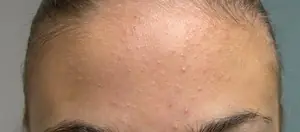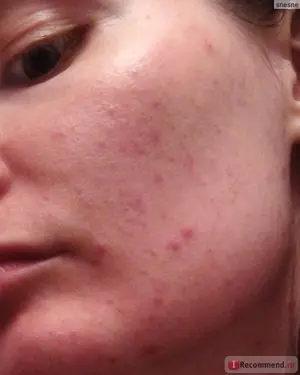
It is known that a rash on the face often forms in adolescents during the period of hormonal changes. But adults also face this unpleasant phenomenon. Rashes can be of various etiologies, are short-term or disappear after some time. There are also types that require contact with a specialist in order to identify or exclude more serious diseases.
Common causes of rashes
Adults should not ignore facial rashes, as the causes can be quite serious. You should not assume that the rash is completely harmless and may go away on its own after some time. The smart human body gives a signal of failure in this way. Therefore regular masking the rash Using tonal products will only temporarily alleviate such an unpleasant situation.
It is imperative to identify why the rash appeared on the face in order to eliminate it in the future. To do this, you need to seek help from a specialist who will prescribe appropriate treatment for rashes on the face of an adult. The most common reasons for their appearance are:
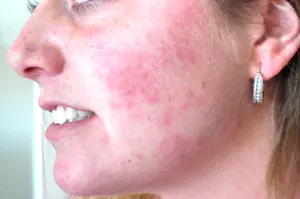
Nervous breakdown. Conflict situations, constant stress, and strong emotional experiences can provoke a rash on the face. The reason for this lies in the action of adrenaline and vasopressin, which are intensely produced in the human body in a state of nervous shock. The rapid release of such hormones disrupts the normal blood flow to the skin, and the skin, in turn, does not receive the required amount of nutrients.- Poor quality cosmetics. It is very common to see rashes on the face of adult women. The reasons for this lie in the use of low-quality cosmetics. Harmful substances are found not only in cheap cosmetics; even expensive brands sometimes cause irritation and rashes. Some facial skin care products contain mineral oils, which create an invisible film on the surface of the skin. This film clogs the pores, limiting air access. In parallel with this, a rapid growth of pathogens begins that cause inflammation. That is why, when choosing cosmetics, it is best to buy one that contains natural ingredients: vegetable oils and glycerin.
- Allergic products. Allergies are a very common cause of facial rash in adults. The list of allergens includes animal hair, plant pollen, medicine or cosmetics. Often inflammation and itching are provoked by certain foods or their components. If you are prone to allergies, you need to pay attention to the quality of the products and also avoid eating citrus fruits, sweets and eggs. During an allergy, the skin begins to swell, itch, and the disease may manifest itself as watery eyes.

Rashes due to illness. The formation of a rash on the face is accompanied by some infectious diseases, for example, scarlet fever, chickenpox, rubella or measles. This is one of the most dangerous causes of skin rashes. Redness and pimples appear on the face as a result of poor functioning of the gastrointestinal tract.- Infestation with parasites. Sometimes parasites living under the skin can trigger rashes on a person’s face. For example, during infection with worms, a person’s face becomes covered with a small rash. Quite often, such rashes are confused with urticaria. The rash is accompanied by the appearance of spots that are itchy and red. Over time, the spots can turn into bursting blisters. Sometimes eczema forms on the skin, the skin begins to peel, and ulcers appear. In this case, it is imperative to undergo an examination and identify the main cause of the formation of unpleasant symptoms.
- Hormonal disbalance. An imbalance of hormones in the human body disrupts the normal course of the menstrual cycle and the development of diseases of the female genital organs. Thanks to this, the female body reacts with the formation of characteristic rashes. If an adult woman develops acne on her face, this indicates problems in the sexual sphere. The cause of this disease may also be menopause, because because of it, hormones begin to go out of their usual rhythm, which in the future leads to skin diseases.
- Low level of hygiene. Failure to comply with personal hygiene rules can lead to the formation of pimples, blackheads and pustules on the face. That is why it is necessary to pay due attention to the skin of the face, thoroughly cleansing it of dust and dirt accumulated during the day. Don't let your pores become clogged. Currently, modern cosmetology can offer many different options for facial skin care. Traditional recipes for cleansing the skin are still relevant.
- Burns of various origins. The most common type of burn on the face is sunburn. If a person is exposed to the scorching rays of the sun for a long time without a hat, his face begins to turn red, itching and a small rash appear. A sunburn is similar to a heat burn. Due to non-compliance with safety precautions, a chemical burn may occur when using products that contain acids and aggressive substances. If the causes of a rash on the face of an adult lie in damage to the skin due to a burn, then in this case superficial treatment is used with the help of creams and ointments.
In addition to these reasons, there are several other unfavorable factors that can lead to rashes on the face. These factors include:
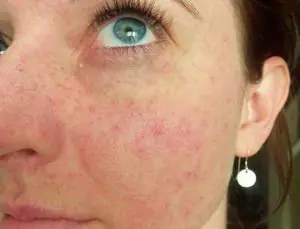
Excess or lack of vitamins. In the cold season, when there is no sunlight, the human body is in dire need of vitamin D. In addition, fluctuating temperatures can negatively affect the condition of the skin. That is why in the cold season it is necessary to take multivitamins, but at the same time we must remember the golden mean, avoiding an excess of nutrients in the body.- Eating fatty, salty and fried foods. Such food, as a rule, has a bad effect on the intestines, which can ultimately result in the formation of rashes on the skin of the face and even on the tongue.
- Bad habits. Drinking alcoholic beverages and smoking are harmful to human internal organs, the condition of which affects the condition of the skin.
- Potent medications. If you take certain medications for a long time and without control, a red rash may form on the tongue and face.
- Skin infections. When infected with streptococcus or other harmful microorganisms, the skin around the mouth is affected.
It is worth paying attention to the fact that the shades of the rash are most often red or pink. If a white rash has formed, this may indicate the appearance of lichen or vitiligo. Vitiligo is incurable and is very sensitive to sunlight and damage.
Features of localization and size of the rash
Of course, a rash on the face cannot occur in an adult for no reason. As you can see, the reasons can be very diverse. Experts have identifiedthat the formation of a rash in certain places is not random and will help you find out which organ is not working correctly:
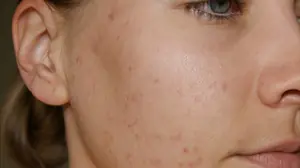
A rash on the cheeks and cheekbones indicates gallbladder dysfunction.- Rashes on the chin indicate the presence of a disease of the genital organs.
- Pimples in the ears are a signal of poor immunity, as well as constant colds.
- Localization of the rash around the oral cavity indicates a malfunction of the gastrointestinal tract.
- Swelling of the eyelids indicates impaired renal function.
- A yellowish tint to the proteins indicates adrenal disease.
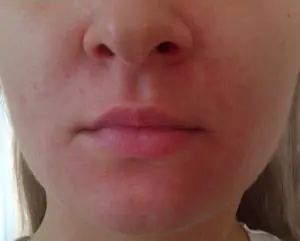
But these statements are not considered fundamental. If red rashes on the face of an adult do not go away on their own for a long time and grow, you need to go to the hospital for advice from a specialist. This is especially true if the rash affects the tongue or lips. After all, this may indicate the presence of an infection, which in the future may spread throughout the mucous membrane.
If you have acne on your face, this stage of the disease can be established simply by counting their number. Up to 10 pimples indicate the initial stage of the disease; external treatment will be sufficient. Up to 40 pimples indicate the second stage of the disease; they are treated both externally and internally. More than 40 pimples indicate a severe stage of the disease. External treatment will not bring any results here. It is necessary to influence from the inside, taking special medications.
Risk group
A facial rash can affect absolutely anyone for one reason or another. But there are still categories that are more often exposed to such an unpleasant illness.
Teenagers aged 16 to 18 years suffer from the appearance of acne on the forehead, bridge of the nose, and cheeks, since it is at this time that hormonal changes begin in their body. Women over 45 years old experience a rash on the skin of the face due to the gradual decline of the ovaries, as well as due to the onset of menopause. People suffering from diseases of the gastrointestinal tract and other internal organs are also susceptible to the formation of a rash on the face.
If a person belongs to one of these categories, then it is necessary to pay special attention to the skin and internal organs. It is recommended to eat properly, eliminating all harmful foods, monitor skin hygiene by cleansing it daily, and also consult with a specialist and follow his recommendations.
Treatment methods at home
Before starting treatment, it is necessary to identify the main cause of the rash on the nose of an adult or on another area of the face. Only then will the treatment be effective and correct. When talking about how to fight and what to do with a rash, you can use both medication and traditional methods of treatment. Traditional recipes for treating skin rashes:

Aloe. This well-known plant can significantly improve the condition of the epidermis. To do this, you need to wipe clean skin with a plant leaf, which must first be peeled, twice a day. Oily and porous skin needs to be wiped with an aloe-based alcohol tincture. To do this, you need to mix four parts of fresh juice with one part of vodka.- Alcohol tincture of calendula. This tincture dries out acne well and removes scars. To prepare the tincture, you need to take 2 tablespoons of flowers and pour 100 ml of vodka over them. The tincture is kept for a week in a dark place, after which it must be strained and the resulting product lubricated the skin three times a day.
- Calendula and honey. This ancient recipe is effective in eliminating inflammation. You need to mix two tablespoons of calendula tincture and honey with a glass of water. The resulting product is wiped over the skin of the face 2 times a day.
- Ice made from chamomile flowers. This remedy eliminates redness and also clears up acne. To make ice, you need to pour one tablespoon of dried flowers into 100 ml of boiling water. When the broth has cooled, pour it into an ice tray and put it in the freezer. Before going to bed and after waking up, wipe your face with ice cubes.
In combination with folk remedies It is recommended to use medications from the pharmacy. In this case, different means are used, depending on the main cause of the rash on the face:
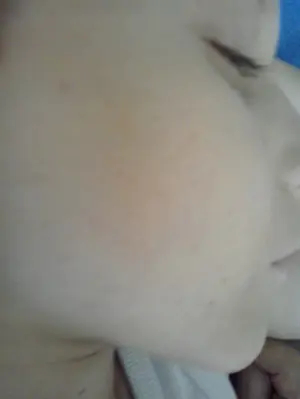
If the cause of the rash on the face is an allergy, first you need to avoid contact with allergens. Tavegil, Diazolin, Suprastin or Loratadine are taken as antihistamines.- If the rash was caused by infectious diseases, then, in addition to antipyretic drugs, a solution of manganese or brilliant green is used.
- If areas on the face have been affected by the herpes virus, then they should be lubricated with Acyclovir cream.
- For sunburn, Pantesol or Panthenol creams are used.
Under no circumstances should you touch the rash with your hands. If you damage the top layer of the blister, new microorganisms will enter the source of inflammation and only worsen the situation. You should also not squeeze out purulent pimples and blackheads. If this does happen, they should be immediately lubricated with brilliant green and a disinfectant.
In this article you will learn why acne can appear at different ages and how to deal with it.
What we used to call acne has many types and scientific names. Depending on the type of acne, we can talk about the severity of the disease and the cause of its occurrence.
Main types of acne:
- Closed comedones - white dots, do not have redness around them, are not painful. They arise due to the closure of the pores by subcutaneous fat.
- Open comedones - black dots. They are also not inflamed or painful. They arise for the same reason as the previous ones. The black color appears due to oxidation of the pore contents.
- Pustules - red, inflamed pimples. May be painful to the touch. Redness indicates that there is an infection at the time.
- Papules - large dense acne with pus inside. They are very painful, the contents may have a greenish tint. They occur when the follicle is repeatedly or severely infected.
- Subcutaneous - are located in the deep layer of the epidermis. They may or may not be painful, with or without redness. They look like lumps, it is impossible to squeeze them out since the pore shaft is not visible.
- Acne conglobata - the most severe degree of acne, in which numerous papules grow together, forming nodules and non-healing wounds on the face.
Comedones can be combated by steaming the skin and mechanical cleaning. For other forms of acne, complex treatment with antibacterial therapy is necessary.
By localization zones
There is an opinion that the exact area in which the rash occurs can indicate which organ needs treatment.
After all, it often happens that acne appears in a specific part, despite the fact that neighboring areas of the dermis can be completely clean.
- Pimples on the forehead can indicate diseases of the digestive organs. Especially due to the heavy load on the liver and intestines when eating sweets, fatty and fried foods.
However, don't panic right away. The forehead area belongs to the T-zone, which is known to be prone to excessive oiliness. Therefore, sometimes the problem can be solved by more careful care of this area.
- The nose also belongs to the T-zone. But acne on the wings and tip can indicate cardiovascular disease. And on the bridge of the nose - about liver diseases.
- Rashes on the chin may indicate diseases of the genital organs. If you have a cold, this may be a sign of a weakened immune system.
- Pimples under the eyes can be a symptom of kidney and adrenal disease.
- Acne on the temples can indicate problems with the spleen and gall bladder.
- Rashes may appear on the cheeks due to respiratory diseases. Therefore, this phenomenon can be found in smokers or people who have hazardous jobs.
Video: Reasons for appearance
Causes of acne breakouts on the face
The main reasons common to all people:
- skin diseases;
- excessive secretion of subcutaneous fat;
- diseases of the digestive organs;
- hormonal imbalances;
- external factors - polluted air, dirty water;
- climate change;
- poor nutrition;
- stress;
- improper skin care, especially poor makeup cleansing;
- allergy;
- heredity;
- working in hazardous conditions (dust, pollutants or chemicals).
The reasons may be individual, depending on age and gender.
Among women
The most common cause of rashes may be the approaching period. This happens due to hormonal changes that affect fat secretion.
Excessively severe acne may indicate gynecological diseases or other hormonal imbalances. For example, hyperandrogenism is excessive production of male hormones.
In men
Acne can occur in avid sports fans due to the use of steroids or glucocorticoids.
The second reason is hyperandrogenism - an excess of androgens stimulates the production of excess subcutaneous fat and, as a result, clogged pores and acne.
During pregnancy
Acne during pregnancy can appear due to a sudden production of hormones and can be a completely normal condition.
Sometimes skin pyodermatitis may develop during pregnancy. This disease appears sharply and acutely during pregnancy or immediately after childbirth.
Papulopustular acne on the face. Detailed treatment here.
In a baby
The appearance of acne can be a normal reaction to changing living conditions. The baby's skin begins to get used to the world around him, and the body itself may contain a large amount of maternal hormones.
These pimples look like white or yellow dots and usually go away on their own within a couple of weeks. If they do not fester and do not cause inconvenience to the baby, there is no need to worry.
An allergy to a product eaten by the mother or to a mixture can also manifest itself in this way.
Miliaria may look like pimples, but appears due to excessive wrapping of the child. In this case, it’s enough just to avoid overheating and the pimples will go away on their own.
However, large or purulent papules may indicate a serious illness. In this case, be sure to consult a doctor.
In teenagers
During puberty, testosterone production increases significantly, which regulates the production of subcutaneous sebum. At this age, the body is especially susceptible to psychological trauma, which also has an extremely negative impact on the dermis.
Children aged 12-14 years are terribly fond of all the “harmful things” - fast food, sweet soda, sweets. This creates additional stress on the digestive organs, which negatively affects appearance.
The relationship between facial rashes and body functions
As can be seen from all of the above, the “purity” of the face directly depends on the functioning of the internal organs and the fluctuations of hormones.
First of all, you should pay attention to the functioning of the intestines. Bacteria help break down beneficial substances and eliminate harmful ones. The formation of acne may indicate that the body is not coping with this function.
Means of prevention and treatment
For hormonal disorders, medications that reduce the production of testosterone or androgens may be prescribed. Women and girls are sometimes prescribed birth control pills.
If acne is caused by diseases of the internal organs, it is necessary to select the appropriate treatment with the help of a therapist and dermatologist.
Antibiotics are used to relieve inflammation. For severe forms or multiple acne, take orally.
Basic antibiotics:
- erythromycin;
- chloramphenicol;
- tetracycline;
- doxycycline;
- Metronidazole.
Ointments for external use
For local treatment, you can use ointments with antibacterial substances. Such medications do less harm and cope well with formations.
These include:
- levomekol;
- erythromycin ointment;
- syntomycin;
- tetracycline ointment;
- zenerite
The active ingredients promote wound healing, relieve inflammation, kill bacteria, dry and disinfect.
Zenerite is the most common remedy for teenage acne. It contains the antibiotic erythromycin and zinc. The latter promotes deeper penetration, dries and starts regeneration processes.
Ointments without antibiotics:
- zinc ointment also disinfects and dries well;
- Ichthyol ointment draws out pus and relieves inflammation;
- skinoren;
- Vishnevsky ointment is well known for its ability to draw out pus. When used, it stimulates blood circulation and renewal of dermal cells.
These ointments have virtually no side effects, are sold without a prescription and have a good effect. It is better to apply it pointwise to problem areas twice a day, after a while rinse with warm water.
Vishnevsky ointment can be applied as a compress to large papules all night; by the morning the contents will come out.
Simple rules for healthy skin:
- Every day, thoroughly cleanse your face of any remaining dirt and makeup. The detergent must be left on for about a minute to remove dirt well.
- Clean your face with a scrub or soft brush 2 times a week.
- After cleansing, do not rub the skin with a towel, but pat lightly.
- If possible, use disposable paper towels for your face.
- Do not squeeze out pimples without steaming the dermis, as this will only push the contents deeper.
- Change the pillowcases on your pillows at least once a week.
- Don't touch your face with your hands.
To effectively combat acne, it is not enough to know a good dermatologist and acquire an arsenal of special cosmetics. Ideally, it is better to prevent a problem, and to do this you need to be aware of its causes.
- Causes of acne
- Acne map on face
- Determining the severity of the disease
- Preventive measures to combat acne
- Tools Overview
Causes of acne
Not so long ago, recurrent acne on the face received the status of a disease called “acne”, or “acne disease”. The attitude towards them has also become more serious, not just as a local cosmetic defect.
A pimple is an inflammatory element. The process of inflammation is associated with the sebaceous gland. When the outflow of sebum is disrupted for some reason, the ducts of the sebaceous glands become clogged, and acne propionbacteria begin to multiply in them.
To date, several factors have been studied that provoke disruption of the outflow of sebum and inflammation of the sebaceous glands.
Floury, sweet and fatty foods are often the causes of acne © iStock
Poor nutrition
Flour, sweets, and fatty foods are blamed for the appearance of acne - however, these three can be blamed for almost any health problem. Indeed, if you remove these foods from your diet, your skin will become noticeably clearer.
Prevention of rashes includes a healthy, balanced diet and the presence of essential vitamins in the diet. In particular, vitamins A, C, group B. To compensate for the deficiency of useful substances, you can take them in tablets or capsules.
Illiterate care
Oily skin is especially prone to increased activity of the sebaceous glands. That is why she needs products designed specifically for her. Cosmetics for other skin types will not be suitable - they are not able to remove excess fat, if we are talking about cleansing and moisturizing properly (to normalize sebum production).
The ducts of the sebaceous glands become clogged with excess sebum, which mixes with dead epidermal cells, particles of makeup, and everyday dirt. In this regard, when caring for oily skin, special emphasis should be placed on cleansing.
Obviously, touching your face with dirty hands or using unwashed brushes for cosmetics means provoking acne.
Hormonal imbalance
To combat acne, products based on zinc, salicylic acid, and clay are produced. © iStock
And if estrogens (female sex hormones) suppress the production of sebum, then androgens (male hormones), on the contrary, stimulate it. In addition, the point is not so much in the excess of androgens, but in the sensitivity of the sebaceous gland receptors to them. Therefore, with the same hormone levels, one person will have acne and another will not.
Acne in a woman after 20-30 years is a reason to visit a gynecologist and endocrinologist.
Diseases
These are mainly problems with the gastrointestinal tract. If there are problems with digestion (including as a result of poor nutrition), the balance of microflora is disrupted. This also affects the condition of the skin.
Digestive disorders lead to an excess of toxins in the gastrointestinal tract, from where they enter the bloodstream and can negatively affect the condition of the skin, contributing to the occurrence of inflammation.
Emotional condition
For a person with problem skin, stress is a powerful risk factor. The pimple pops up at the most crucial moment, because this moment is associated with emotions and excitement.
“It is known that the stress hormone cortisol provokes increased production of sebum and, as a result, clogged pores,” explains Vichy brand expert Elena Eliseeva.
For the same reason, the connection between deterioration in skin quality and lack of sleep becomes clear. Lack of sleep is also stressful for the body.
Stress and lack of sleep often trigger rashes. Avoid both. © iStock
Climatic factor
Subcutaneous mite
Demodex (subcutaneous mite) is a rather controversial cause of acne. It lives in the skin of 80% of people, but begins to cause trouble, including acne, only against the background of additional health problems or allergies to its waste products.
Acne map on face
Most often, the localization of the rash indicates that it is in this area that the sebaceous gland receptors are very sensitive to the effects of hormones. It is believed that the location of the rash can determine the nature of the problems in the body. In fact, dermatologists do not support this theory, but for general information we will still write about it.
“Favorite” places for acne to appear are the forehead, nose, and chin. © iStock
Part of the so-called T-zone. There are many sweat and sebaceous glands located here, so the skin is often characterized by increased oiliness. It is believed that rashes on the forehead indicate diseases of the large and small intestines.
In adolescence, acne on the cheeks predominates in boys. If acne appears in this area in women, it makes sense to check the hormonal system and intestines.
The nose is also part of the T-zone, where there are many sebaceous and sweat glands.
Here, acne no longer appears in adolescence, but after 30. They are usually associated with hormonal disorders and gynecological problems.
Determining the severity of the disease
The more rashes and inflammations, the more severe the disease. If we are not talking about single pimples, you should consult a dermatologist.
Preventive measures to combat acne
Clear skin for people whose skin is prone to breakouts is the result of careful daily care. It looks something like this.
Cleansing using a special product: it will remove excess sebum, impurities, and makeup.
Washing using gel or foam for oily or problem skin and toning. Once or twice a week, deep cleansing using clay-based masks is recommended (an approximate scheme for such cleansing is given below).
Hydration – a mandatory step in caring for oily skin. Lack of moisture provokes increased production of sebum. Due to the use of aggressive cleansers, oily skin often becomes dehydrated. It urgently needs moisture to maintain hydrolipid balance. Moisturizing normalizes sebum secretion, which helps fight inflammation and infection.
Camouflage imperfections using foundation, corrector or powder designed specifically for problem skin.
© skin.ru
Tools Overview
Acne prevention program. Cleansing
As a cleansing gel, it cleanses and mattifies the skin. If used as a scrub, it exfoliates and prevents pore clogging. As a mask, it deeply cleanses pores and visually tightens them (apply for 3 minutes, rinse with warm water).
eucalyptus extract, salicylic acid, zinc
Suitable for pre-cleansing before washing: removes makeup, removes impurities.
Completes the cleansing process and tightens pores.
salicylic acid, zinc
Deeply cleanses problematic skin.
two types of mineral clay, thermal water with selenium
Cleanses the skin of excess sebum and impurities, reduces blackheads, pimples and their marks.
charcoal, salicylic acid, blueberry extract
Exfoliates the skin, effectively cleanses pores, prevents the appearance of acne and fights existing ones.
charcoal, salicylic acid, blueberry extract



